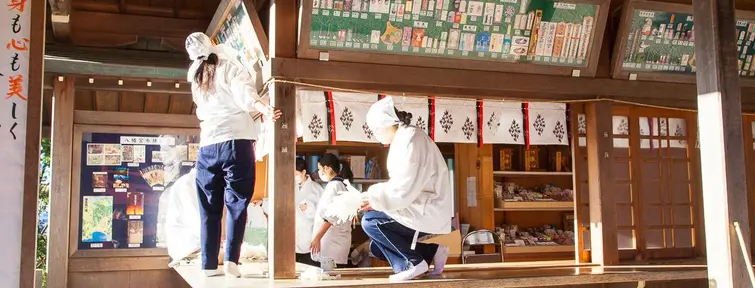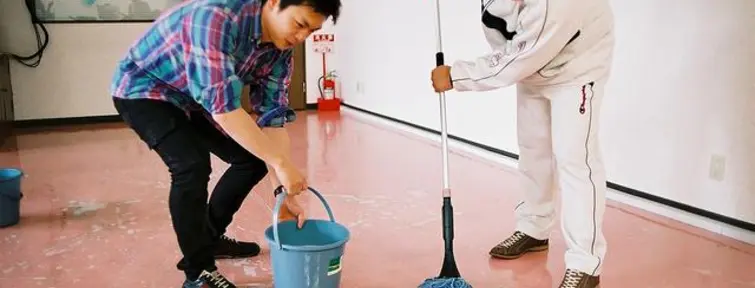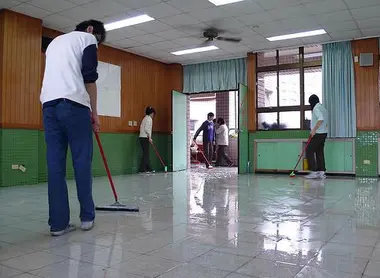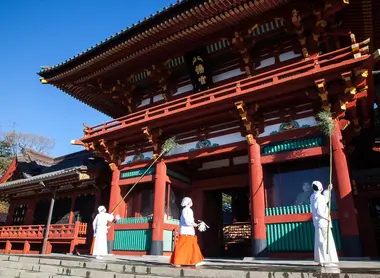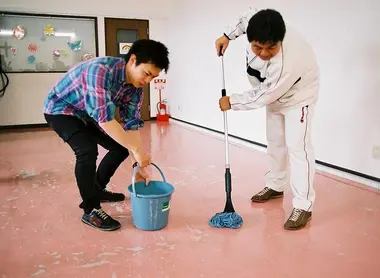Ôsôji: Japanese-style cleaning
Ôsôji, the Japanese tradition of end-of-year cleaning, is deeply rooted in Japanese culture. Much more than a simple house-cleaning, this ritual symbolizes purification and renewal in the run-up to the New Year. Loaded with spiritual and practical significance, Ôsôji reflects the Japanese approach to respect and harmony with one's environment. However, despite its cultural importance, this practice seems to be losing ground in modern Japanese society. Let's explore the origins, practices and contemporary challenges of this unique tradition, which continues to shape the Japanese relationship with their living space.
The origins and significance of Ôsôji
Ôsôji, which literally means "great cleansing", has its roots in Shinto beliefs. Traditionally, each family cleaned the family altar on the last day of the year to honor the arrival of the God of the New Year. This practice spread from 1640, during the Edo period (1603-1867), when Edo Castle began to be cleaned from top to bottom every December 13, the former last day of the year.
The custom, originally known as susuharai (literally "soot removal"), gradually spread to all levels of society, from samurai to commoner. The Ôsôji became a means of purifying one's environment to welcome the New Year and the kami (Shinto spirits or deities). The ritual also symbolizes the end of bad experiences, regrets and failures of the past year, paving the way for a new beginning.
The Ôsôji process: a thorough cleansing
Ôsôji is much more than a routine house-cleaning. It's an exhaustive cleaning of the entire house, where every nook and cranny is carefully treated. From windows to baseboards, from the underside of furniture to the back of appliances, nothing is left to chance. Japanese families take this task very seriously, and it's common to see all members actively participating in the housework.
The process also involves the sorting and elimination of unnecessary or cumbersome items, reflecting the Japanese concept of "mottainai", which expresses regret at waste. This step creates a more uncluttered and serene space, ready to welcome in the New Year. In the offices, old papers are discarded and files reorganized. As for the students, they tidy up their desks, taking part in the collective purification effort.
Oshôji in contemporary Japanese society: statistics and trends
Despite its cultural importance, the Ôsôji seems to be losing its appeal among modern Japanese. According to a survey carried out by cleaning equipment company Duskin in January 2023, only 51.8% of households claim to have cleaned up by the end of 2022. This is the lowest rate since the first survey in 2005, and a far cry from the record 71.7% recorded at the end of 2008.
Trends vary according to household type: those with minor children are more inclined to practice Ôsôji (60.3%), while households with members aged 60 and over are more likely to abandon it (47.8%). A new trend is also emerging: more and more people are using professional cleaners for Ôsôji, rising from 2.4% in 2012 to 8.6% by the end of 2022.
How to perform Ôsôji at home: practical advice
For those wishing to adopt the practice of Ôsôji, here are a few tips for integrating this spirit of deep cleaning into your end-of-year routine:
- Planning and preparation: Set a date for your big clean and prepare all the necessary tools in advance.
- Zoning: Divide the work by dividing your home into several zones, either by room or by category of object.
- Decluttering: Take the opportunity to sort through your belongings and get rid of unnecessary items.
- Deep cleaning: Clean every nook and cranny, including often overlooked areas such as behind appliances or the tops of cupboards.
- Organization and tidying: Reorganize your spaces to create a more functional and serene environment.
Don't hesitate to involve all family members in this process, as the Japanese traditionally do. This can be an excellent opportunity to prepare together for New Year's Day in Japan, creating an atmosphere conducive to celebration and renewal.
The modern challenges of Ôsôji: between tradition and evolution
The Ôsôji faces a number of challenges in contemporary Japanese society. The accelerated pace of life and changes in family structures sometimes make it difficult to practice this time-consuming ritual. In addition, the evolution of modern housing, often smaller and better equipped with cleaning appliances, changes the nature and scope of the task.
Nevertheless, the spirit of Ôsôji persists in new forms. For example, some companies organize collective cleaning days before the New Year vacations, thus perpetuating the tradition in a professional context. Similarly, the growing popularity of professional cleaning services for Ôsôji testifies to the adaptation of the practice to modern constraints.
The impact of Ôsôji on family relationships and couple dynamics
The Ôsôji reveals interesting disparities in the perception and practice of cleaning within Japanese couples. According to Duskin's survey, while 90.9% of husbands are satisfied with their wives' contribution to end-of-year cleaning, only 68.8% of wives can say the same about their partners. The problems raised by wives are revealing: "He says he likes things to be clean, but he doesn't do anything about it", or "He looks at his smartphone or the TV while I'm cleaning".
These observations underline the importance of Ôsôji as a revealer of family dynamics and expectations regarding the sharing of household chores. They also highlight the persistent challenges of gender equality in the domestic sphere in Japan, even during traditional rituals such as Ôsôji.
Adapting Ôsôji to an international context: lessons to be learned
Although Ôsôji is deeply rooted in Japanese culture, its principles can be adapted and appreciated in other cultural contexts. The idea of an annual cleansing as a means of purification and renewal can be universally appealing. It offers an opportunity for reflection and refocusing, while creating a clean and orderly environment for the year ahead.
In an international context, Ôsôji can be seen as a practice of mindfulness and gratitude towards one's living space. It can be combined with other end-of-year traditions, such as the festival of seven herbs (Nanakusa no sekku), to create a meaningful personal or family ritual. The key is to capture the spirit of Ôsôji: a moment of pause to clean up, tidy up, and prepare mentally and physically for a fresh start.
By adopting certain aspects of Ôsôji, we can not only improve our physical environment, but also cultivate an attitude of respect and gratitude towards our living space. This practice can help us to leave behind negative energies, as the Japanese symbolically do, and welcome the New Year with a renewed spirit and harmonious environment.
Les défis modernes de l'Ôsôji : entre tradition et évolution
L'Ôsôji fait face à plusieurs défis dans la société japonaise contemporaine. Le rythme de vie accéléré et les changements dans les structures familiales rendent parfois difficile la pratique de ce rituel chronophage. De plus, l'évolution des logements modernes, souvent plus petits et mieux équipés en appareils de nettoyage, modifie la nature et l'ampleur de la tâche.
Cependant, l'esprit de l'Ôsôji persiste sous de nouvelles formes. Par exemple, certaines entreprises organisent des journées de grand nettoyage collectif avant les congés du Nouvel An, perpétuant ainsi la tradition dans un contexte professionnel. De même, la popularité croissante des services de nettoyage professionnels pour l'Ôsôji témoigne d'une adaptation de la pratique aux contraintes modernes.
L'impact de l'Ôsôji sur les relations familiales et la dynamique de couple
L'Ôsôji révèle des disparités intéressantes dans la perception et la pratique du nettoyage au sein des couples japonais. Selon l'enquête de Duskin, si 90,9% des maris se disent satisfaits de la contribution de leur épouse au nettoyage de fin d'année, seulement 68,8% des femmes peuvent en dire autant de leur partenaire. Les problèmes soulevés par les épouses sont révélateurs : "Il dit qu'il aime que les choses soient propres, mais il ne fait rien pour", ou encore "Il regarde son smartphone ou la télé pendant que je nettoie".
Ces observations soulignent l'importance de l'Ôsôji comme révélateur des dynamiques familiales et des attentes en matière de partage des tâches ménagères. Elles mettent également en lumière les défis persistants en matière d'égalité des sexes dans la sphère domestique au Japon, même lors de rituels traditionnels comme l'Ôsôji.
L'adaptation de l'Ôsôji dans un contexte international : leçons à tirer
Bien que l'Ôsôji soit profondément ancré dans la culture japonaise, ses principes peuvent être adaptés et appréciés dans d'autres contextes culturels. L'idée d'un grand nettoyage annuel comme moyen de purification et de renouveau peut être universellement attrayante. Elle offre une opportunité de réflexion et de recentrage, tout en créant un environnement propre et ordonné pour l'année à venir.
Dans un contexte international, l'Ôsôji peut être vu comme une pratique de pleine conscience et de gratitude envers son espace de vie. Il peut être combiné avec d'autres traditions de fin d'année, comme la fête des sept herbes (Nanakusa no sekku), pour créer un rituel personnel ou familial significatif. L'essentiel est de capturer l'esprit de l'Ôsôji : un moment de pause pour nettoyer, ranger, et se préparer mentalement et physiquement pour un nouveau départ.
En adoptant certains aspects de l'Ôsôji, nous pouvons non seulement améliorer notre environnement physique, mais aussi cultiver une attitude de respect et de gratitude envers notre espace de vie. Cette pratique peut nous aider à laisser derrière nous les énergies négatives, comme le font symboliquement les Japonais, et à accueillir la nouvelle année avec un esprit renouvelé et un environnement harmonieux.
